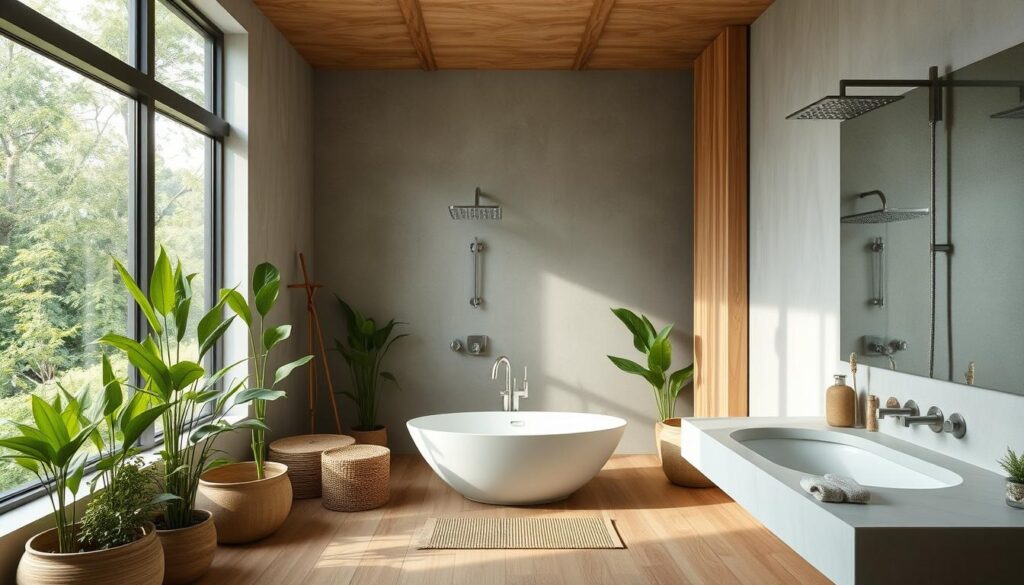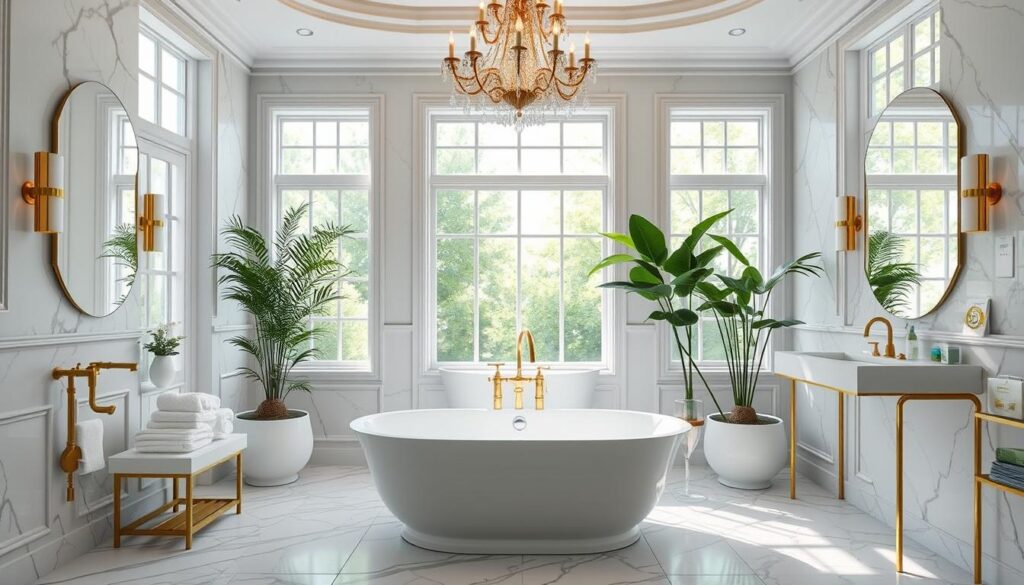Your basement is more than just storage. A basement remodel can turn this underused area into a valuable part of your home. You can add a guest suite, home theater, or cozy family room. These changes boost your home’s value and create spaces you’ll love.

Basement finishing opens doors to endless possibilities. Imagine a home theater with soundproofing or a guest bedroom with a private bathroom. Smart home features like automated lighting or a modern fireplace can make the space feel luxurious. Even a simple storage overhaul with built-in shelves adds practicality and style.
Every basement renovation idea listed here combines function and flair. From a fitness area with mirrored walls to a wine cellar with custom racks, each choice enhances daily life. High-quality finishes like durable flooring and decorative beams ensure longevity and beauty. Whether you choose a kids’ playroom or a home office, these upgrades add both comfort and equity.
Start exploring how a basement renovation can transform your home. With options from DIY storage projects to hiring professionals, there’s a plan for every budget. Begin today to enjoy more space and a better investment.
Why Remodel Your Basement?
Turning an unfinished basement into a useful space is a smart move. It transforms unused areas into valuable living spaces. This boosts comfort and adds to your home’s value.
Homeowners can use the extra room for hobbies, guests, or even to earn money. This is all without the need for expensive additions.
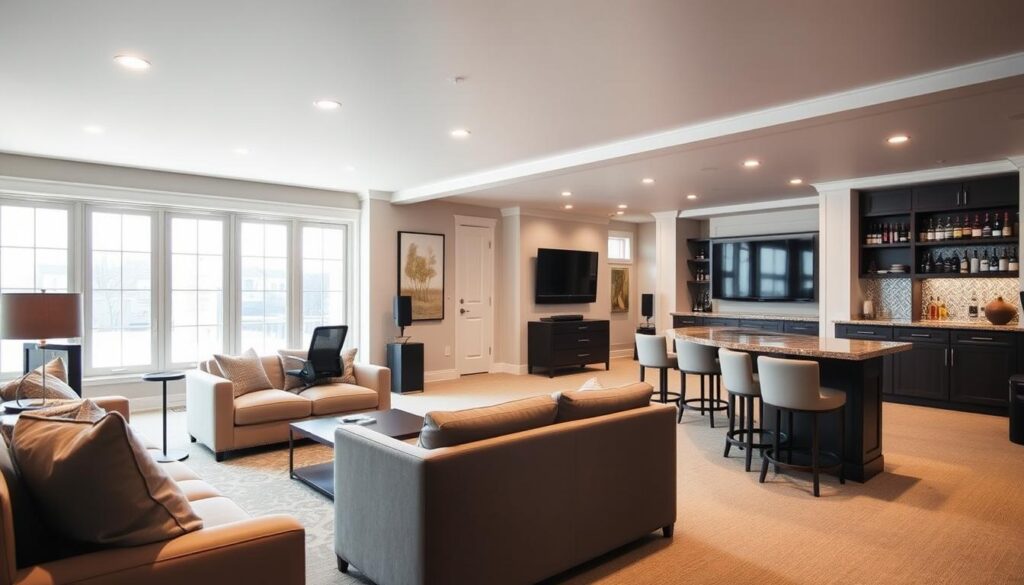
Benefits of a Finished Basement
Key advantages include:
- Increased home value through added square footage
- Potential for 86% return on investment (per the 2022 Remodeling Impact Report)
- Custom basement design options like home theaters or guest suites
- Energy-efficient insulation reducing heating/cooling costs
| Benefit | Impact |
|---|---|
| Extra space | Creates family rooms, offices, or rental income |
| Higher resale value | Attracts buyers seeking multi-functional homes |
| Cost of basement remodel | Averages $15,000–$35,000, often recouped at sale |
| Flexibility | Adaptable to future needs like home gyms or playrooms |
Smart basement design balances looks and function. It creates spaces that are good for families and future buyers. A finished basement is a key asset in any home, whether for fun, storage, or making money.
Why Remodel Your Basement?
Finishing your basement is more than just a lifestyle upgrade. It’s a smart investment. A basement remodel before and after project can increase your home’s value by up to 86%. This makes it one of the best home improvements.
Professional basement remodeling contractors focus on every detail. They ensure the space is both functional and safe. This is what buyers look for most.
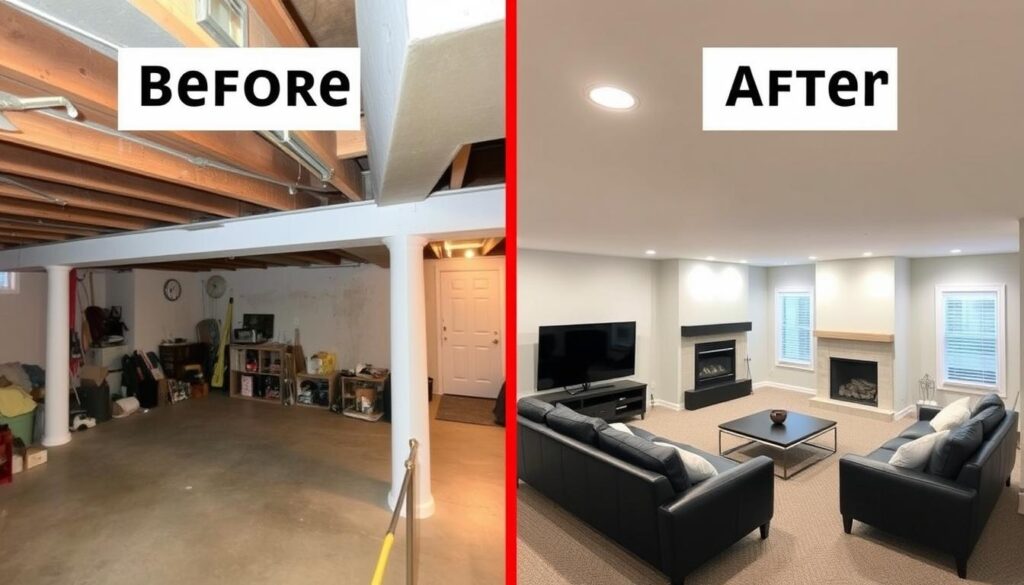
- Finished basements recoup 70-86% of costs, outperforming kitchen or bathroom upgrades in some markets.
- Add a bathroom or home office to turn the space into a marketable asset, reducing time on the market by weeks.
- Energy-efficient features like insulation and waterproofing cut utility bills while enhancing resale appeal.
“A basement remodel can make a home feel 20% bigger without the cost of an addition,” says Mark Thompson, a certified realtor in Texas. “Buyers love seeing before and after transformations that add bedrooms or entertainment zones affordably.”
When choosing a basement remodeling contractor, look for someone who knows how to make the most of small spaces. Creative layouts, like foldable walls or hidden storage, can turn cramped areas into game rooms or guest suites. Even small updates, like proper lighting or drywall, can make a big difference.
Investing in smart features like soundproofing or climate control can add value. The right basement remodeling contractor will balance looks and function. They’ll turn your vision into a valuable asset.
Popular Basement Layouts
When choosing a basement layout, you have two main options. You can go for an open layout or create separate zones. Open layouts are great for flexibility, while defined spaces are perfect for specific activities. Each style has its own benefits, depending on what you need.
Open Concept vs. Defined Spaces
Open layouts remove walls to make your basement feel bigger. This is perfect for parties or playtime. On the other hand, defined spaces like theaters or reading nooks can be tailored for specific activities.

- Open Concept: Great for family rooms or game areas. It encourages people to interact. Adding large windows or faux skylights brings in more natural light during basement finishing.
- Defined Spaces: Perfect for home offices or gyms. These areas use partitions or furniture to separate functions without needing full walls.
Why not mix both for the best of both worlds? You could have a big open lounge next to a soundproofed media room. Professional contractors can handle any structural issues during basement construction. Whether you want something versatile or specialized, planning carefully ensures your basement fits your lifestyle.
Popular Basement Layouts
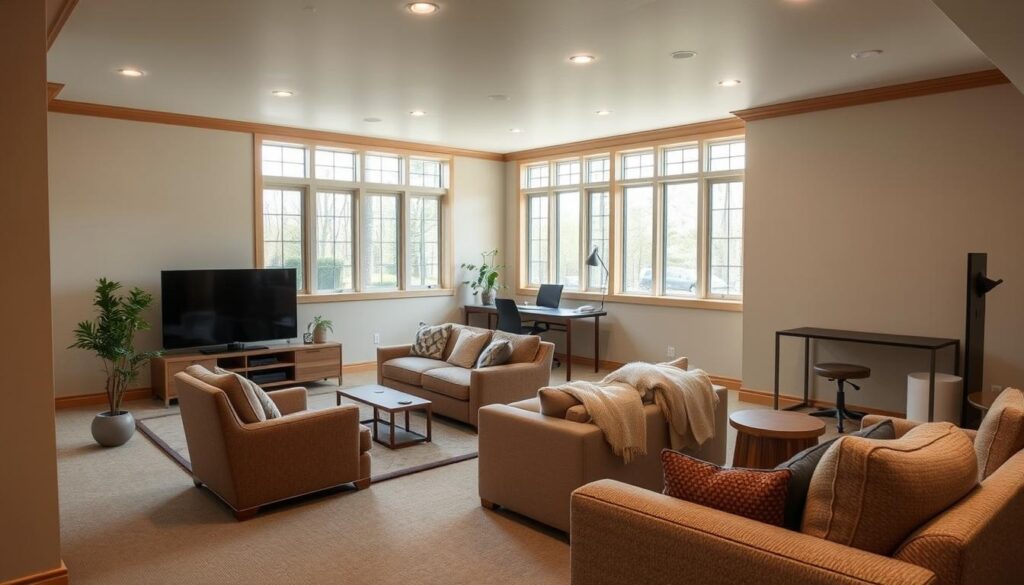
Make the most of your basement with multi-functional designs that grow with you. Need a home office by day and a guest room at night? Or maybe a game zone that turns into a study area? Smart basement remodeling ideas turn small spaces into dynamic hubs. Modern basement renovation focuses on flexibility, using space-saving solutions like modular furniture.
Brands like IKEA and West Elm offer modular furniture for easy room changes. A sleeper sofa, extendable tables, or wall-mounted desks make rooms versatile. Built-in storage from The Container Store keeps clutter hidden, making space for different activities. Sliding partitions or fold-down workstations let corners switch between workspaces and entertainment areas seamlessly.
- Office-Guest Bedroom Hybrid: Pair a Murphy bed with a fold-down desk for weekday work and weekend guests.
- Family Multipurpose Room: Install a kitchenette with under-counter storage for snacks and game accessories.
- Play and Study Zones: Use sliding panels to separate play areas from homework stations.
Light colors and open layouts make small basements look bigger. A modern fireplace or hidden bookcase entry adds style without losing function. Always check local codes, like egress windows for bedrooms. Basement renovation experts suggest using movable dividers for privacy and space. Choose furniture that does double duty, like storage benches or coffee tables with compartments, to keep things tidy.
Home Theater Ideas for Your Basement
Basements are great for home theaters because of their thick concrete walls. These walls help block out noise. A basement remodel for movies needs to focus on sound quality and keeping it in. The best basement remodelers can help pick the right materials and layout for your basement theater.
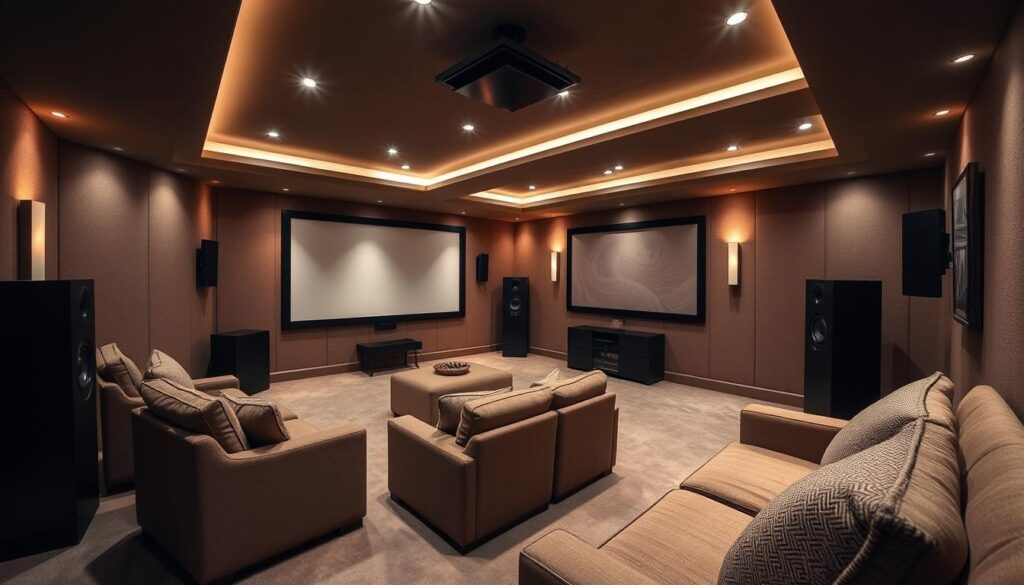
Acoustics and Soundproofing Tips
First, work on the acoustics to stop echoes and outside noise. Important materials include:
- Acoustic panels to soak up sound waves
- Bass traps for controlling low sounds
- Diffusers to spread sound out evenly
To keep sound from leaking, use resilient channels and special drywall. Also, solid-core doors and insulation between floors are key if your basement is under living areas.
| Consideration | Details |
|---|---|
| TV Size | Choose a screen size that fits your room. The Samsung The Wall (292-inch model) gives a big-screen feel. |
| Lighting | Use dimmable LED strips or blackout curtains for projector setups. |
| Acoustics | Put acoustic boards on walls to cut down echo. |
“Professional consultation ensures your theater balances style and sound quality,” says Basements Plus, a leader in basement entertainment spaces.
Add comfy seating like tiered platforms or cozy sectionals. The top remodelers can mix these elements while keeping costs down. Focus on a layout that meets your movie-watching needs.
Home Theater Ideas for Your Basement
For a home theater that feels like a luxury cinema, comfy seating is essential. Whether you’re redoing your basement renovation or updating your basement design, the right seats make all the difference. First, measure your space to make sure seats face the screen right.
Experts say seats should be 1.5–2.5 times the screen’s diagonal size away. This keeps eyes comfortable during movies.
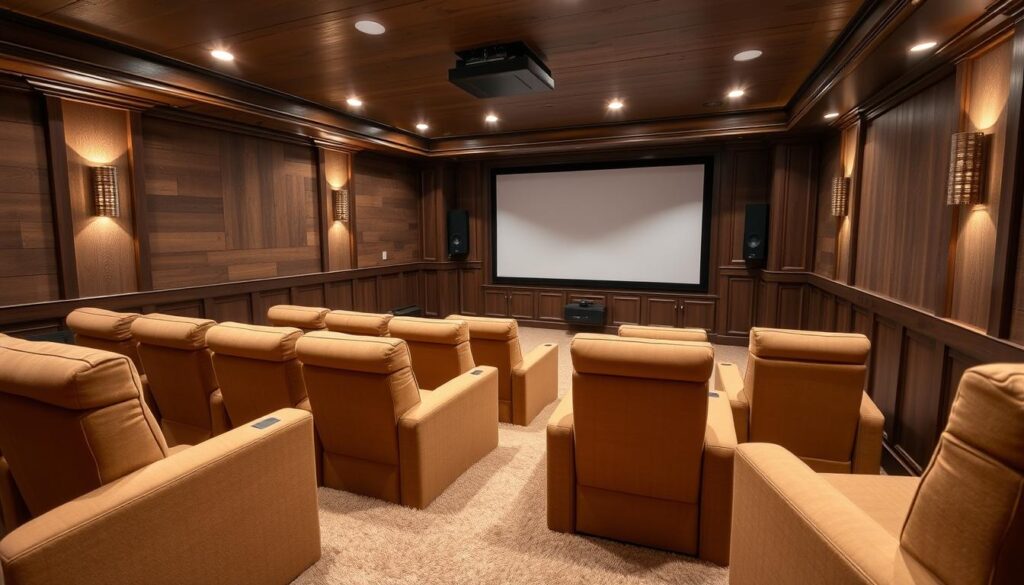
- Recliners: Motorized or manual, they let viewers relax during long films.
- Sectional sofas: Great for small basements, they save space and offer cozy comfort.
- Tiered platforms: Raised rows ensure everyone sees the screen, perfect for big groups.
Adding extras like cup holders, side tables, or storage under seats enhances the experience. Modular furniture is great for basements that need to be versatile. For families, choose fabrics that are easy to clean.
Make sure to leave 3–4 feet between rows for easy movement. A concession stand nearby adds convenience without cluttering the seating area. Smart home tech, like voice-controlled recliners or automated lighting, can enhance the setup. Every detail, from seat spacing to cushion firmness, affects comfort. Choose layouts that fit your space and style!
Creating a Cozy Family Room Downstairs
Turning your basement into a cozy family spot begins with the right furniture. Choose pieces that are both comfy and practical. Use soft fabrics like linen or velvet to add warmth. Make sure they’re durable for busy areas.
When picking furniture, make sure it fits the room well. Avoid clutter by choosing items that match the room’s size. This is especially important in basements with lower ceilings.

“Moisture-resistant materials are key—look for frames treated for humidity and easy-to clean upholstery.”
Choosing the Right Furniture
Begin with a key piece like a chaise sectional (110.5” wide) in linen or boucle. Its design fits any room layout. Add to it:
- Upholstered armchairs (31.5” high) in linen and wood for contrast
- Multipurpose stools (14” deep) with leather or metal accents
- A round coffee table (40” diameter) with wood and linen blends
Add warmth with chunky knits, faux fur throws, and a plush rug. Use a 39”-high bar stool near a built-in counter. For small areas, choose wall-hugging recliners or compact storage ottomans. Pick furniture under 300 lbs for easy moving during basement remodel projects.
Creating a Cozy Family Room Downstairs
Lighting is crucial for making a basement welcoming. Smart choices in basement design balance style and function. During a basement renovation, aim for layers to add warmth and versatility.
- Combine recesseded LEDs, wall sconces, and table lamps for layered lighting. Mix ambient, task, and accent fixtures to adapt to any mood.
- Use dimmers to adjust brightness. Smart switches let you set scenes for movie nights or game time.
- Reflect light with mirrors placed opposite windows or lamps. They expand small spaces and reduce shadows.
- Warm wood tones in floors or furniture add coziness. Pair with textiles like faux fur or woven rugs for texture.
- Choose high-LRV paints in deep reds or neutrals to maximize brightness. Add LED strips under shelves for subtle glow.
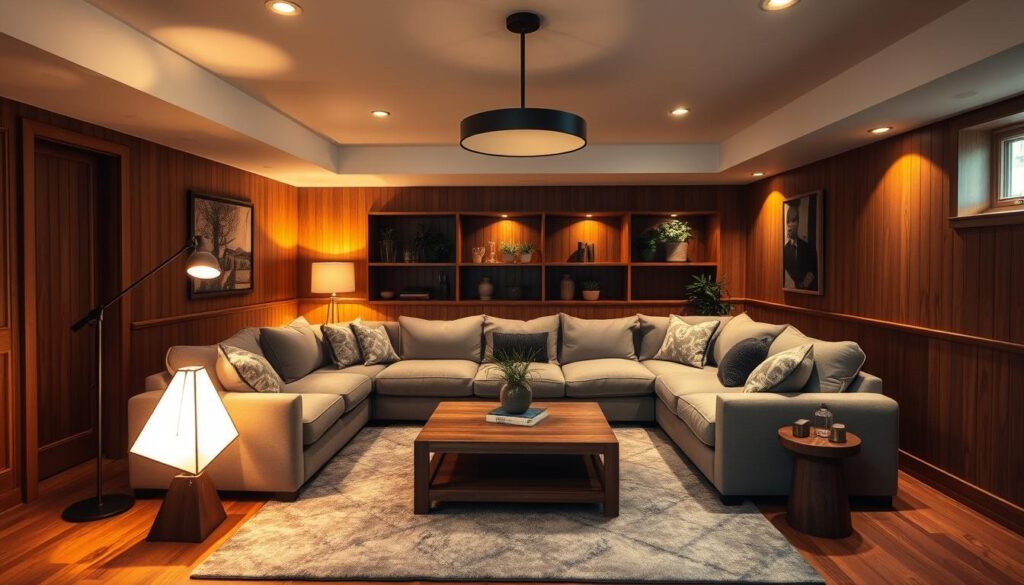
A successful basement renovation balances practicality and ambiance. Mix fixtures like pendant lights or floor lamps to highlight seating areas. Soft lighting near seating zones encourages relaxation. Prioritize flexibility so the space works for play, relaxation, or gatherings.
Transforming Your Basement into a Home Office
Turning your basement into a home office is a smart basement remodeling idea for remote workers. Proper basement construction details like lighting and ventilation ensure comfort. But, ergonomic furniture is key to long-term health. Start by prioritizing your well-being while designing this space.
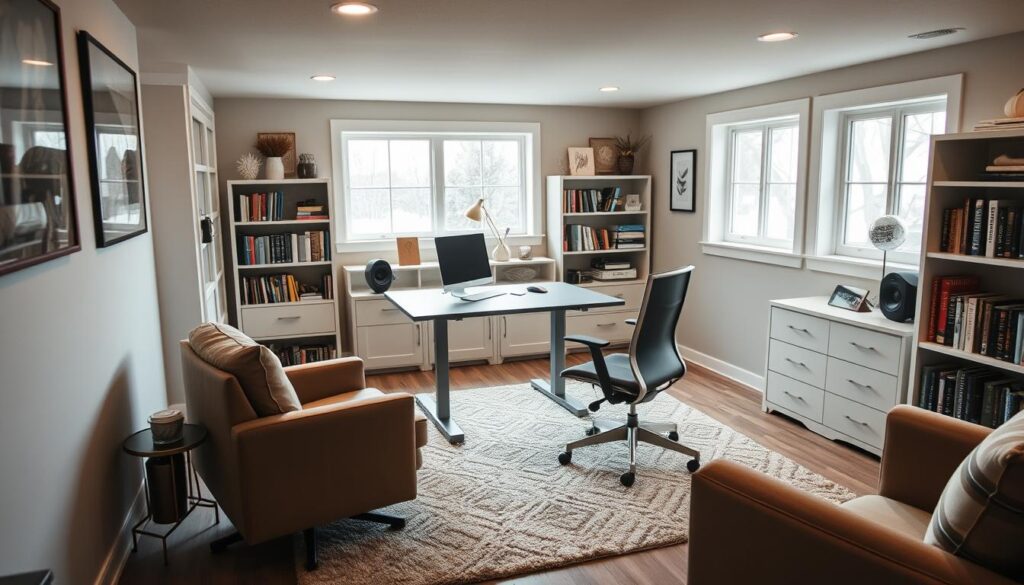
Ergonomic Furniture Choices
Choose furniture that supports posture and efficiency. Start with an adjustable desk like the Steelcase Adjustable Desk. It allows you to switch between sitting and standing. Pair it with a chair featuring lumbar support, such as the Herman Miller Aeron Chair, to reduce back strain.
- Use monitor arms to position screens at eye level, cutting neck strain.
- Opt for storage solutions like modular shelving from IKEA to keep supplies organized without clutter.
- Include a footrest or ergonomic keyboard tray for added comfort during long work sessions.
Custom cabinetry can hide cables and maximize space during basement construction projects. Prioritize breathable fabrics and non-slip flooring to enhance comfort. For larger basements, add a small coffee station with a mini-fridge and charging hubs. Always test furniture arrangements before finalizing layouts to ensure ease of movement.
Transforming Your Basement into a Home Office
Creating a home office in your basement is more than just setting up a desk. It’s about installing tech that keeps your work flowing smoothly. A basement remodeling contractor can design systems that meet your power, connectivity, and comfort needs.
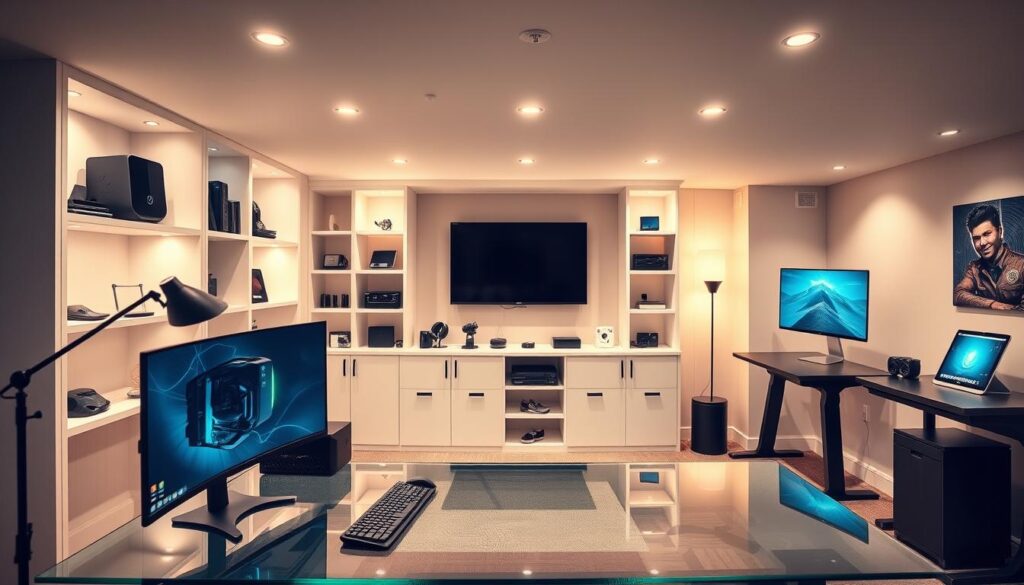
Essential Tech Upgrades
- Power Solutions: Add dedicated electrical circuits for computers and servers. Place outlets near work areas and use surge protectors to prevent outages.
- Internet Reliability: Use a mesh Wi-Fi system or hardwired Ethernet cables to eliminate dead zones. This keeps video calls and file transfers smooth.
- Cable Management: Route wires through hidden channels or wall sleeves to keep the space tidy and safe.
- Lighting: Mix LED overhead lights with desk lamps for even illumination. Dimmable fixtures let you adjust brightness for focus or relaxation.
- Climate Control: Ensure HVAC systems handle heat from electronics. Add vents or a mini-split AC unit if needed.
A basement remodeling contractor can also install acoustic panels or soundproof flooring to reduce noise. They’ll check for existing wiring issues and update systems to meet modern standards. Planning for future tech needs—like extra outlets or smart home integrations—makes your space adaptable as your work style evolves. Prioritize safety and functionality to create a space that supports productivity without sacrificing comfort.
Designing a Functional Guest Suite
Turning your basement into a guest suite is all about finding the right balance. A well-thought-out basement renovation can make your guests feel right at home. At the same time, it keeps your living space separate.

Privacy Considerations
Here are the first steps for basement finishing:
- Use solid-core doors with key locks for entryways.
- Add sound-dampening insulation in walls and ceilings to block noise.
- Include a separate entrance or hallway to reduce shared space overlap.
Lighting and decor play a big role in privacy. Mix dimmable overhead lights with table lamps for a cozy feel. Choose neutral colors like beige or soft gray to keep things calm and private.
Comfort is key. Add a mini kitchenette with a microwave and fridge for convenience. Make sure there’s a private bathroom with heated floors and modern fixtures. Blackout curtains on windows help control light.
Don’t forget about safety. Install smoke detectors and make sure emergency exits are clear. These touches turn your basement renovation into a cozy guest suite that’s both private and stylish.
Designing a Functional Guest Suite
Turning your basement into a guest suite makes visiting more comfortable. A smart basement remodel can make it a cozy spot. Focus on basement design that looks good and works well.
- Install egress windows to meet safety codes and boost natural light.
- Opt for quality bedding and storage solutions like built-in closets.
- Incorporate a private bathroom and small kitchenette for convenience.
- Ensure proper insulation and dehumidification for year-round comfort.
Here are some design tips for a guest suite:
| Feature | Why It Matters |
|---|---|
| Insulation methods (e.g., furring walls) | Reduces drafts and improves energy efficiency |
| Access to plumbing | Facilitates bathroom and kitchenette installations |
| Code-compliant ventilation | Ensures safety and resale value |
A guest suite boosts your basement design by adding privacy and value. Think about adding a mini-fridge or charging stations for extra comfort. Also, waterproofing and ventilation during a basement remodel prevent moisture problems. Whether for a quick visit or a long stay, the right touches matter a lot.
Kids’ Play Areas: Safety and Fun
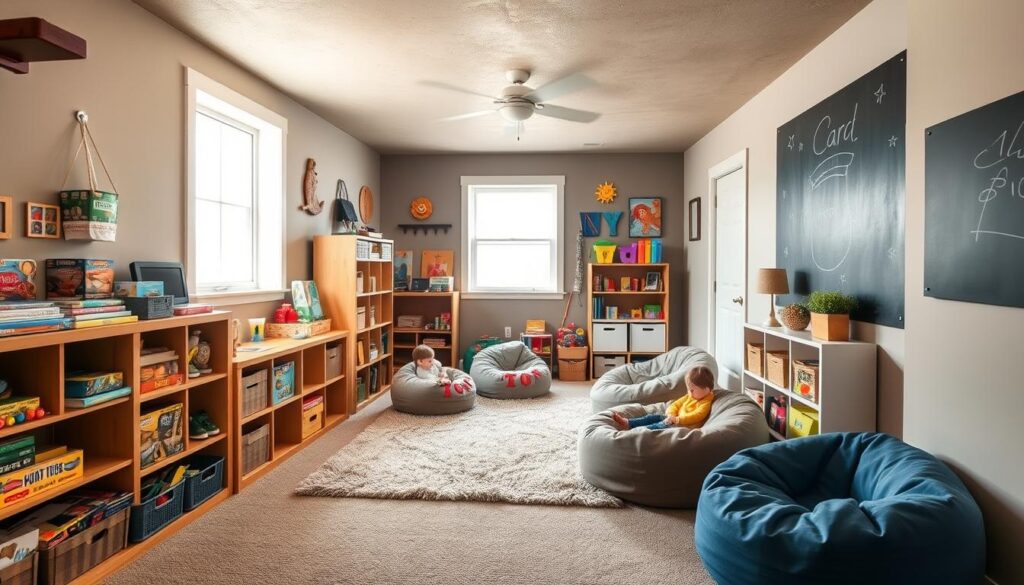
Turning your basement into a play area for kids? Focus on safety and fun with smart basement remodeling ideas. Choose soft floors like EVA foam tiles or rubber mats to prevent falls. Add basement renovation tricks like built-in storage to keep toys organized and the area clean.
Creative Storage Solutions for Playrooms
Here are some smart ways to use space:
- Built-in Shelves: Install wall-mounted cubbies and open shelves for easy toy access.
- Under-Stair Storage: Use nook spaces for bins or drawers to hide clutter.
- Vertical Storage: Hang floating shelves or pegboards to save floor space.
| Storage Solution | Materials | Benefits |
|---|---|---|
| Built-in cabinets | MDF or laminate | Maximizes vertical space and hides clutter |
| Roll-out bins | Plastic or fabric | Easy access for seasonal toys |
| Wall hooks | Metal or wood | Hang backpacks, coats, and games |
Make the space safe and fun. Use rounded furniture edges, secure heavy items, and label bins clearly. Bright colors and themed decor make it welcoming. With the right basement remodeling ideas, every corner becomes a place for learning and fun.
Kids’ Play Areas: Safety and Fun

Turn your basement into a magical place where kids can dream big. Themed decor makes it safe and fun. The top basement remodelers can make these ideas real, fitting your child’s interests.
Themed Decor Ideas
Create immersive zones with these popular themes:
- Underwater Oasis: Coral reef murals, blue LED lights, and fish-shaped shelves.
- Galaxy Lair: Star-projector lights, blacklight-reactive paint, and rocket ship play structures.
- Enchanted Forest: Treehouse nooks, faux moss walls, and animal-themed storage bins.
| Theme | Key Features |
|---|---|
| Space Exploration | Star maps on ceilings, astronaut wall decals, and “control panel” desks |
| Wild West | Log cabin playhouses, sheriff badge hooks, and tumbleweed rugs |
| Construction Zone | Tool-shaped decor, sand tables, and mini bulldozer toy zones |
“Themed play areas boost creativity while fostering motor skills,” says the International Play Equipment Manufacturers Association.
Make sure to add safety features like cushioned floors and rounded edges. Use modular storage to keep toys organized and change themes as kids get older. The best basement remodelers can also add egress windows or impact-resistant materials to meet safety standards while keeping it fun.
Wine Cellars and Bars: A Tasteful Addition
Turning a basement into a wine cellar or bar adds class and usefulness. A smart basement remodel boosts your home’s value and creates a special place for friends and family. The right design makes sure your space looks great and works well.
Essential Design Elements
First, plan the layout to mix storage and social areas. Use open shelving or glass cabinets to show off your collection while keeping it dust-free. For bars, add under-counter fridges and mini-fridges to keep drinks cold.
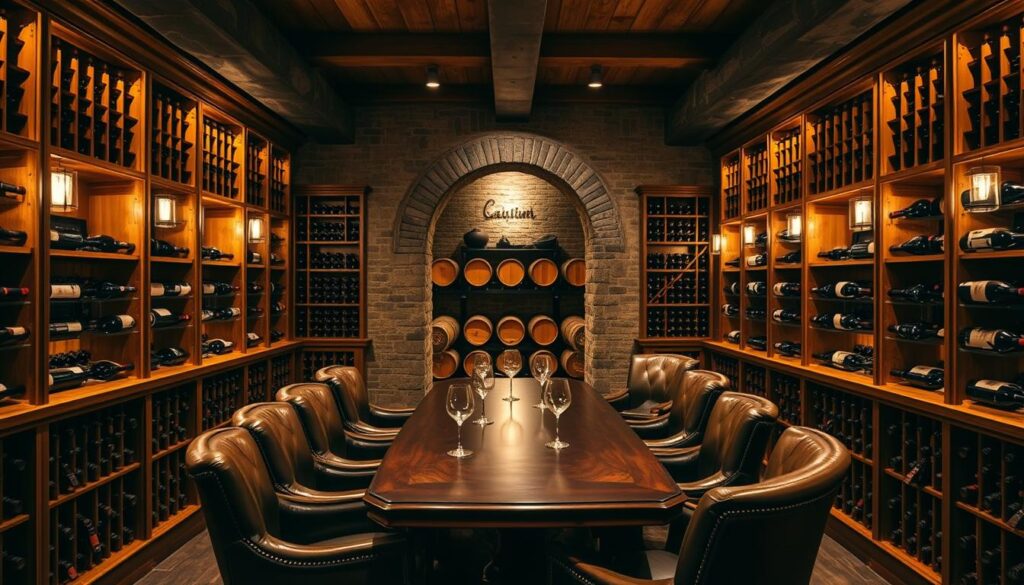
- Climate Control: Install systems to keep humidity and temperature right for wine.
- Countertops should be 18-24 inches deep for serving and seating.
- Choose lighting that shows off bottles without heating them up, like LED strips or indirect lights.
“A functional wine cellar needs precise temperature zones and strong shelving to hold weight.”
When building your basement, make sure the floors can handle heavy storage. Use moisture barriers to avoid water damage and plan for plumbing, like sinks or ice makers. Choose durable materials like quartz for countertops and dark wood for floors to add beauty. A well-thought-out layout makes it easy to get to storage and seating, making your basement perfect for entertaining.
Add themed decor, like rustic beams or modern lights, to match your taste. Whether you have a big wine collection or a small bar, smart design makes your basement a highlight.
Wine Cellars and Bars: A Tasteful Addition
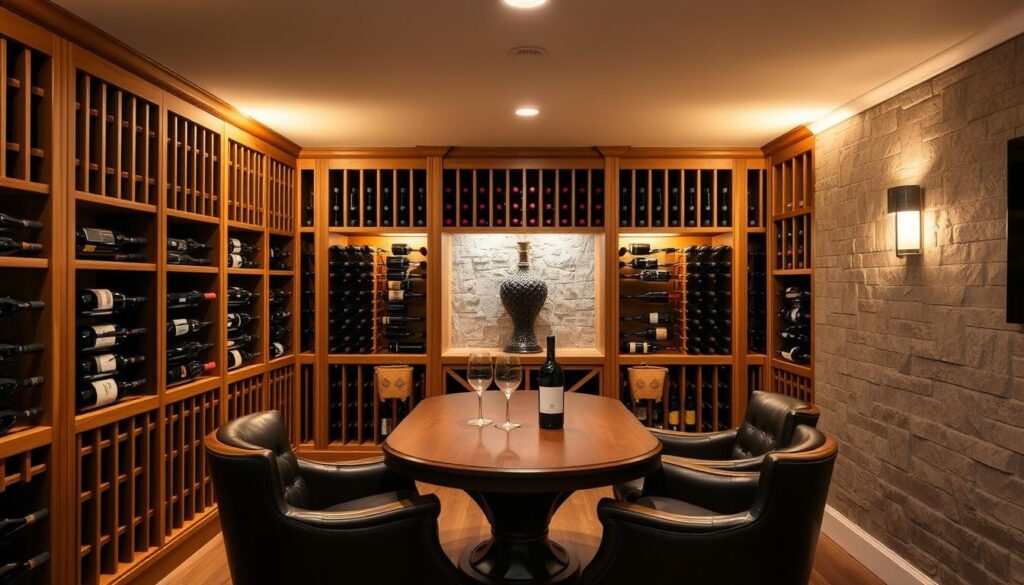
Creating a wine cellar or bar in your basement is more than just about looks. It’s about keeping your wine collection in top shape. A good basement remodeling contractor will make sure your space looks great and keeps your wine perfect.
Best Wine Storage Practices
Here are some important tips for keeping your wine:
- Climate control: Keep it at 55°F (13°C) and 60-70% humidity. You can use wine refrigerators or whole-room HVAC systems.
- Light and vibration: Stay away from direct sunlight and loud noises to avoid disturbing the bottles.
- Storage orientation: Lay bottles down to keep the corks moist and the seals tight.
| Temperature (°F) | Humidity (%) | Material Tips |
|---|---|---|
| 50-60 | 60-70 | Use wood or stone for insulation and style |
Custom basement renovation projects often include vertical racks and glass doors. A basement remodeling contractor can install systems like those in a Dublin home’s Tuscany-style cellar or a modern Powell project with stone accents. With the right planning, your collection will stay perfect, and your space will be a great place to entertain.
Exercise and Fitness Spaces
Transform your basement into a basement remodel dream with a fitness area. A well-designed basement design turns workouts into a home value booster. First, decide what you want to do in your space—cardio, strength training, or yoga. Then, choose the right gear that fits your budget and space.
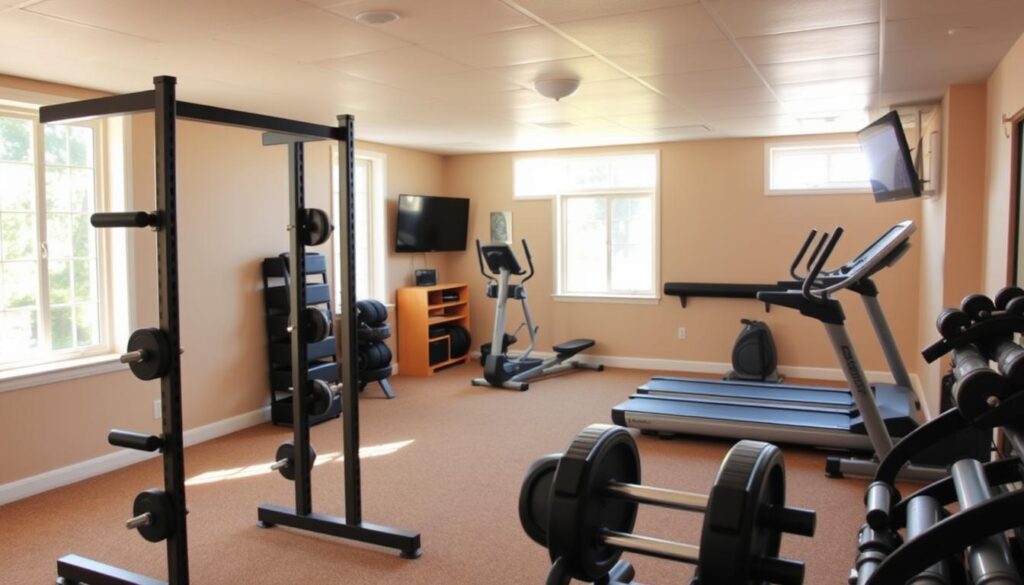
Start with durable flooring. Rubber mats or vinyl panels are good for joints and quiet. Key tips:
- Secure heavy equipment like treadmills on concrete floors to prevent damage.
- Mount racks and shelves on walls to free floor space.
- Include a relaxation corner with seating for post-workout recovery.
Equipment Selection and Layout
Divide your space into zones for cardio, strength, and stretching. Keep 3–5 feet between each piece for safety. Use mirrors for form checks but avoid glare or safety hazards.
| Equipment | Space Required | Storage Tips |
|---|---|---|
| Treadmill | 8×4 ft minimum | Wall-mounted hooks for accessories |
| Weight Racks | Corner placement | Overhead racks for plates |
| Yoga Mats | Flexible zones | Stackable storage units |
Ensure good air flow with fans and windows. A dehumidifier keeps moisture in check. Rubber flooring helps absorb shock. Aim for a layout that’s both stylish and practical, turning your basement into a fitness haven.
Exercise and Fitness Spaces
Transforming your basement into a motivational gym starts with basement remodeling ideas. Make a dull area into a high-energy gym with design details that boost focus. Start by removing walls for mirrors to track form and make the room feel bigger. Use bright colors like electric blue or fiery red on accent walls to increase intensity.

- Mirrors: Full-length panels improve form while making small spaces feel larger.
- Color Psychology: Choose red tones for high-intensity zones or cool greens for yoga areas.
- Tech Integration: Mount a TV for streaming workouts and add waterproof speakers for upbeat playlists.
- Motivational Touches: Frame workout quotes or hang progress charts to stay goal-focused.
Proper basement finishing ensures functionality. Use rubber mats or foam tiles for joint protection. Waterproof walls with vapor barriers guard against moisture. Add ventilation fans and LED lighting for a bright, fresh feel.
“A well-designed basement gym combines style and safety,” says ElkStone Basements. “Prioritize slip-resistant floors and moisture-proofing to protect your investment.”
Stay within budget by mixing new gear with used items. Store weights on wall-mounted racks to keep the space clutter-free. For recovery, add a small corner with a yoga mat and calming plants.
Every detail from flooring to decor matters. Turn your basement into a space that pushes you to hit fitness goals without breaking the bank. Let’s get sweating in style!
Designing a Laundry Room Basement
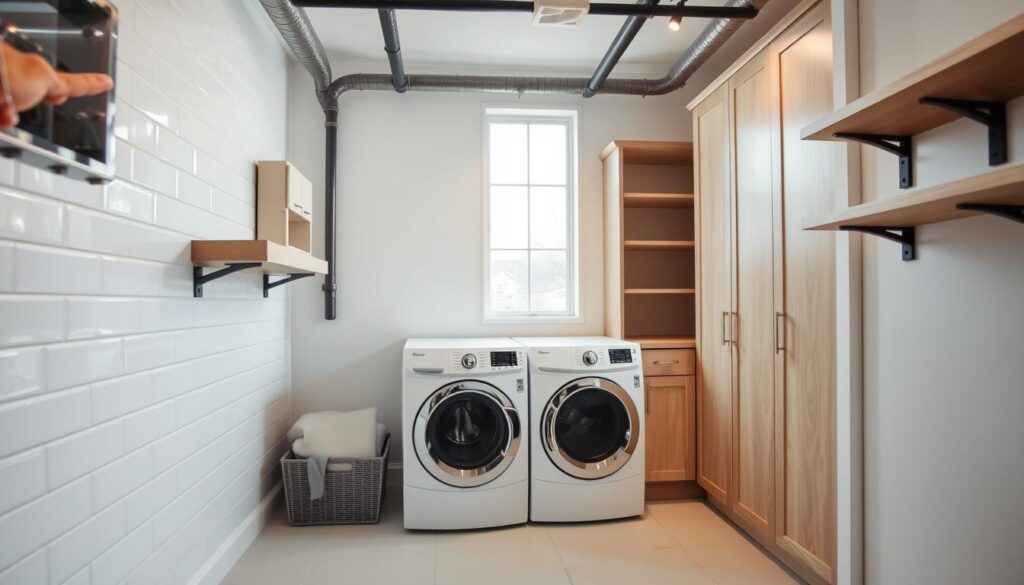
A well-planned basement remodel can make an unused space useful. Begin by planning the path between washer, dryer, folding area, and storage. This reduces steps. Also, don’t forget to address waterproofing and drainage early to prevent problems later.
Efficiency Ideas for Laundry Spaces
Here are some smart ways to use small spaces:
- Install L-shaped countertops for sorting and folding near appliances
- Mount a peg rail above counters to hold hangers and laundry baskets
- Use vertical cabinets to store detergents and supplies overhead
| Storage Option | Features | Benefits |
|---|---|---|
| Hampton Bay cabinets | Modular designs | Customizable layouts |
| Shiplap walls | Coastal aesthetic | Light-reflecting surfaces |
| Tile flooring | Non-porous material | Ease of cleaning |
Consider adding a utility sink for rinsing items. Choose Hampton Bay Ready To Assemble cabinets for a budget under $5,000. Use The Home Depot’s project calculators to plan materials. A small folding island with a hamper can help keep things organized and clean.
Designing a Laundry Room Basement
Turning a basement laundry room into a functional space needs creative storage ideas. Proper basement finishing makes every corner useful. First, figure out your space and needs before picking solutions.
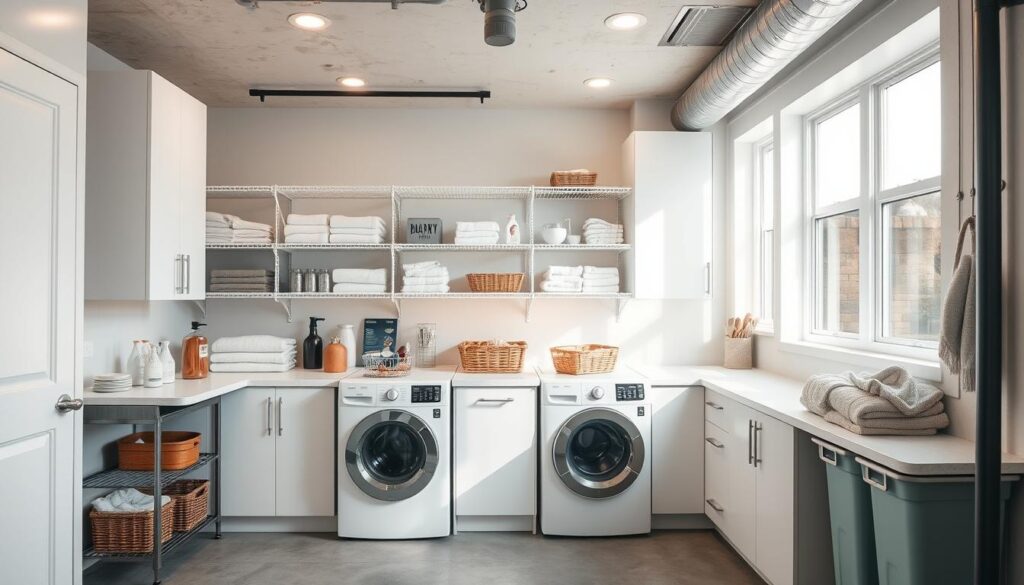
Smart Storage Solutions
Here are some space-saving tips:
- Install built-in cabinets with pull-out bins for detergents and hangers.
- Use vertical space with adjustable shelving and hanging rods above appliances.
- Opt for moisture-resistant materials like PVC or stainless steel in damp areas.
- Include divided drawers for small items like buttons or safety pins.
Also, add design elements that work well:
- Add a folding surface on top of washers/dryers to streamline workflows.
- Paint walls white to brighten spaces and hide minor stains.
- Use floating shelves to keep clutter off the floor while maintaining airflow.
Keep delicate items safe in sealed cabinets. For example, install a tray to organize supplies neatly. Mixing closed cabinets with open shelving creates balance. Always leave clearance around appliances for safety during a basement renovation.
Tips for Hiring a Contractor for Your Remodel
When you’re looking for a basement remodeling contractor, being prepared is key. Begin by asking friends or checking out professional groups like NARI and NAHB for recommendations. Make sure to ask contractors to show you their portfolio and references from past clients.
- Do you specialize in basement projects? Check experience with similar subterranean renovations.
- How do you handle moisture control? Verify waterproofing and drainage system expertise.
- Are you licensed and insured? Confirm liability and workers’ comp coverage.
- Can you show permits and past inspections? Proof of code compliance is essential.
It’s important to review contracts carefully. They should include:
- Material brands and quantities
- Timeline milestones
- Change order policies
- Warranty details
| Payment Phase | Percentage | Description |
|---|---|---|
| Deposit | 10% | Paid upfront to secure the project |
| Phase 1 | 25% | After major work like framing or plumbing |
| Phase 2 | 25% | Upon completion of insulation or electrical systems |
| Final | 15% | After final inspection and walkthrough |
Always ask for a detailed cost breakdown. Materials usually make up 40% of the total cost. Keep 10-20% extra for unexpected expenses. Schedule regular meetings and daily inspections. A clear contract protects your investment and ensures the work is done safely and meets code standards.
Tips for Hiring a Contractor for Your Remodel
Setting a budget and picking the right contractor are crucial for a successful basement remodel. Knowing the cost helps you set realistic goals and ensures your vision fits your budget. Start by making a list of all expenses, including materials and permits.
Consider factors like moisture issues or plumbing changes that might increase costs.
Budgeting for Your Project
Choose contractors who specialize in basements to avoid hidden costs. Ask about their experience with challenges like water damage or structural repairs. Many 203(k) loans offer financing options, making larger projects more affordable.
Always check reviews on Google, Yelp, or the Better Business Bureau to assess their track record. Look for basement remodel before and after examples to see their past work quality.
Ask contractors about their process for handling delays or unexpected issues. Make sure they’re licensed, insured, and clear about payment schedules. Prioritize clear communication and a detailed contract outlining timelines and costs.
A well-planned budget paired with a reliable contractor turns your basement into a valuable space. It shows dramatic before and after results.
More Basement Remodel ideas
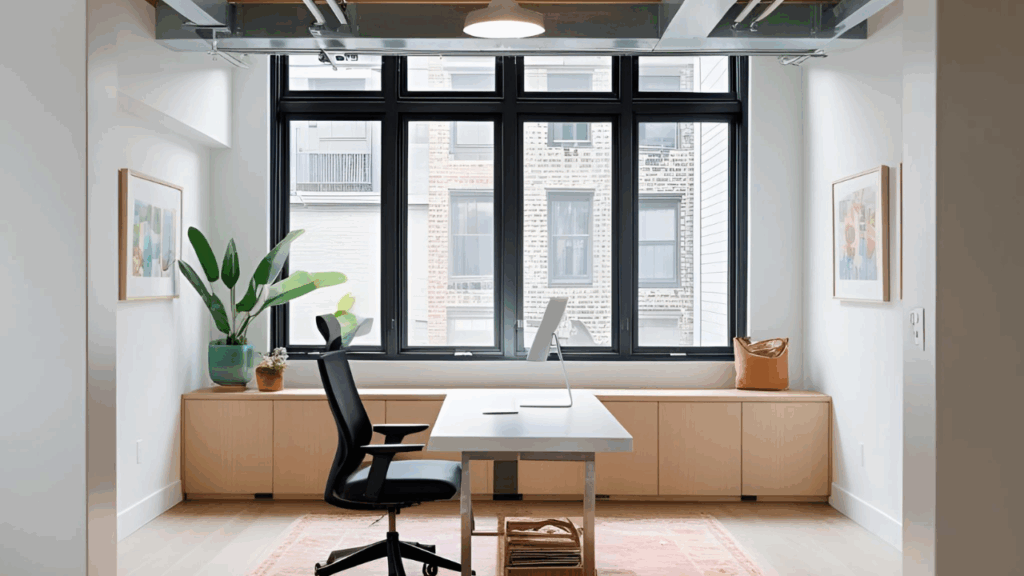
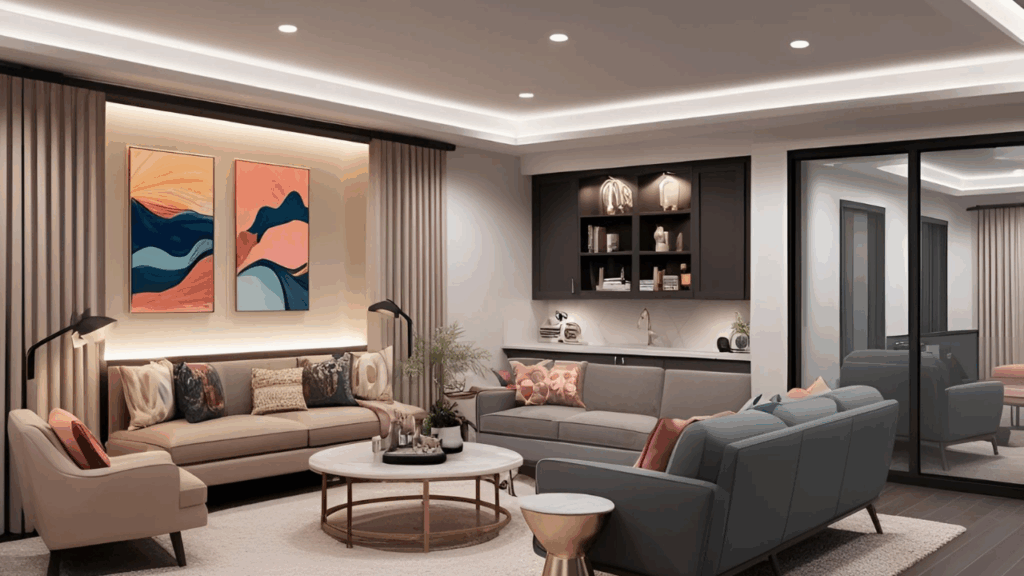
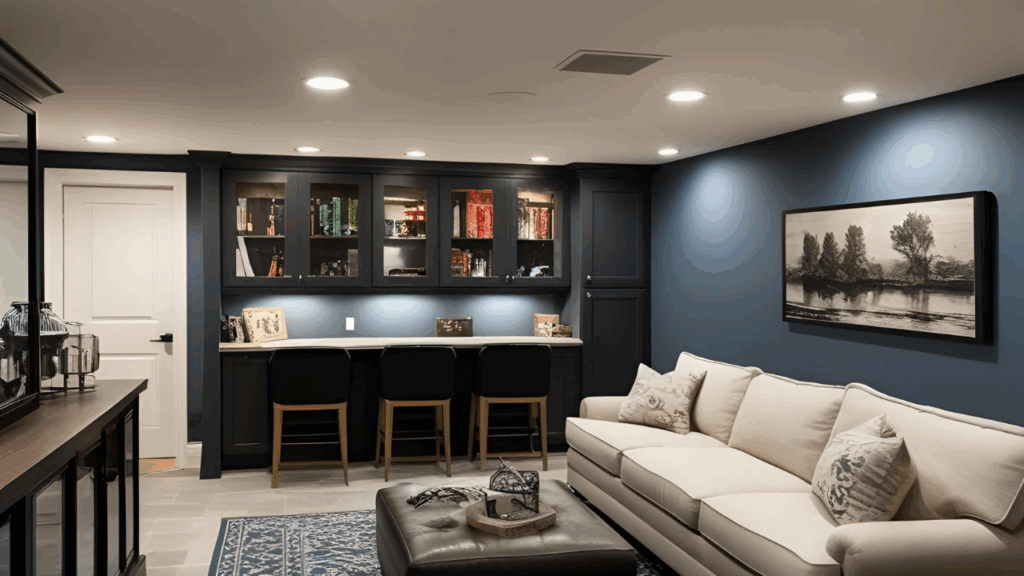
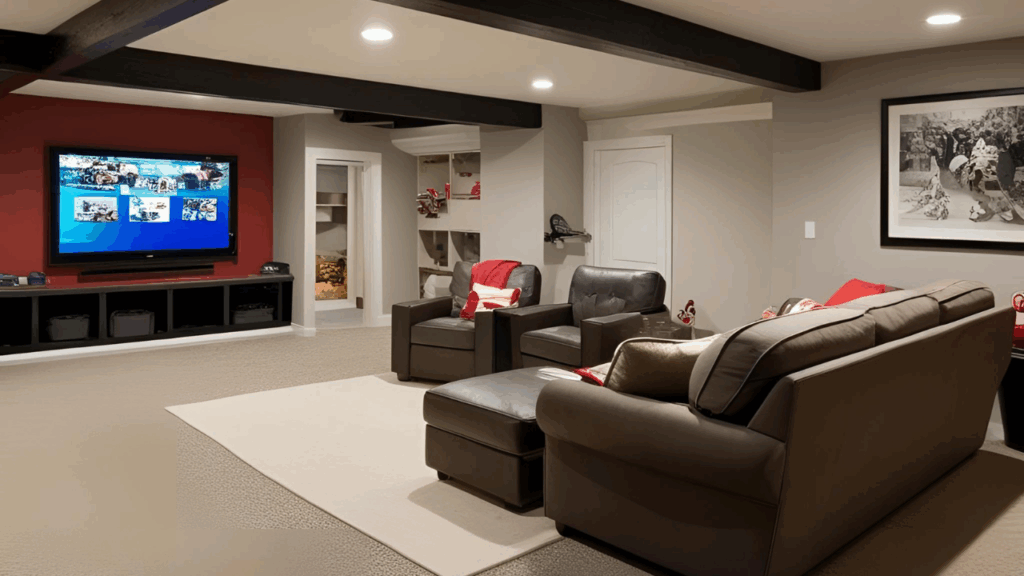
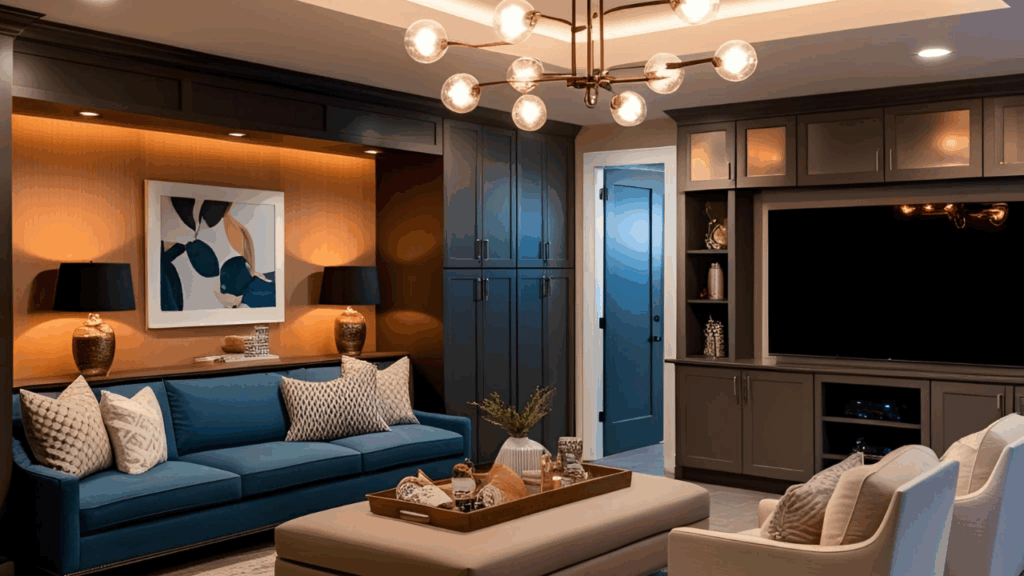
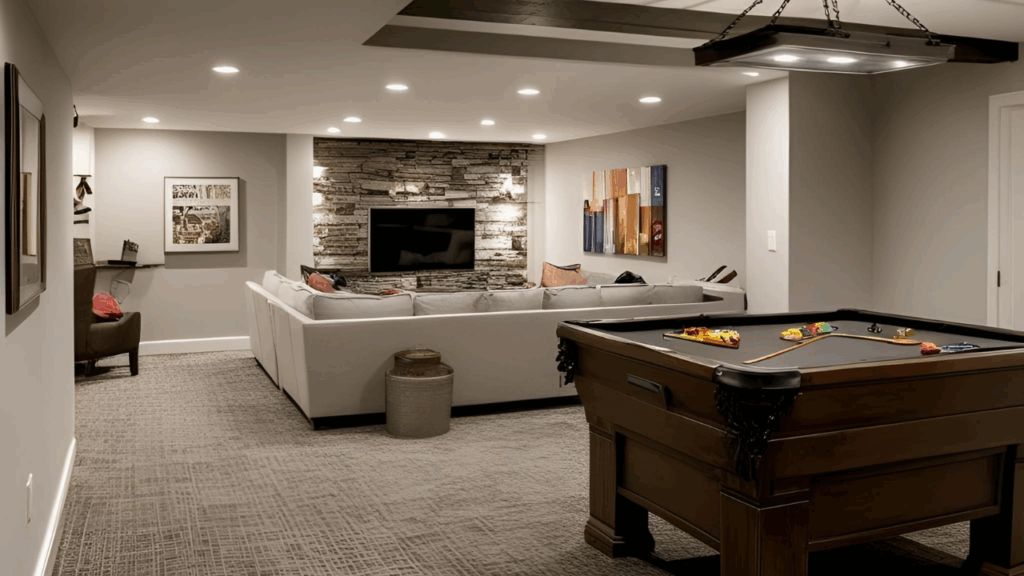
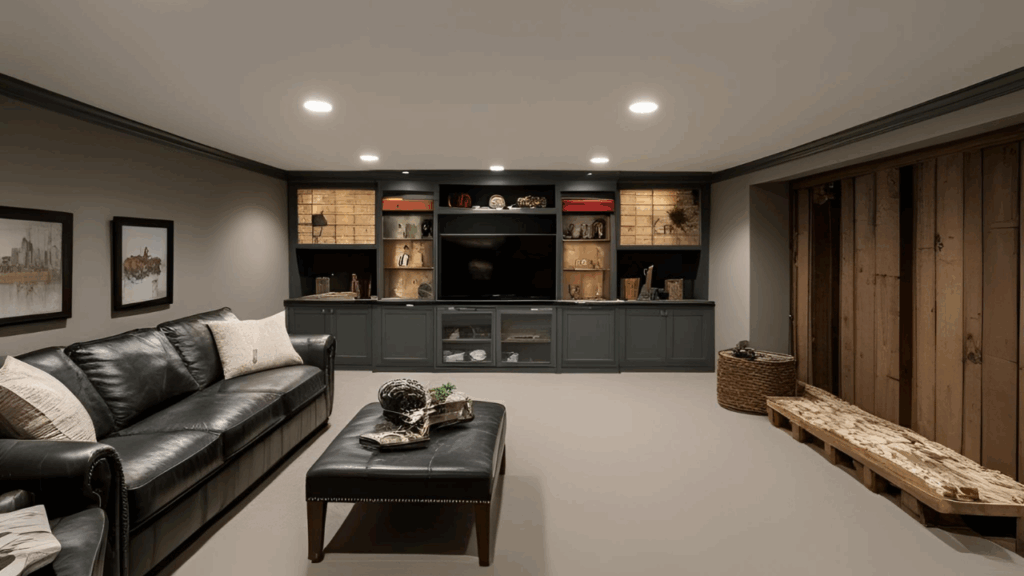
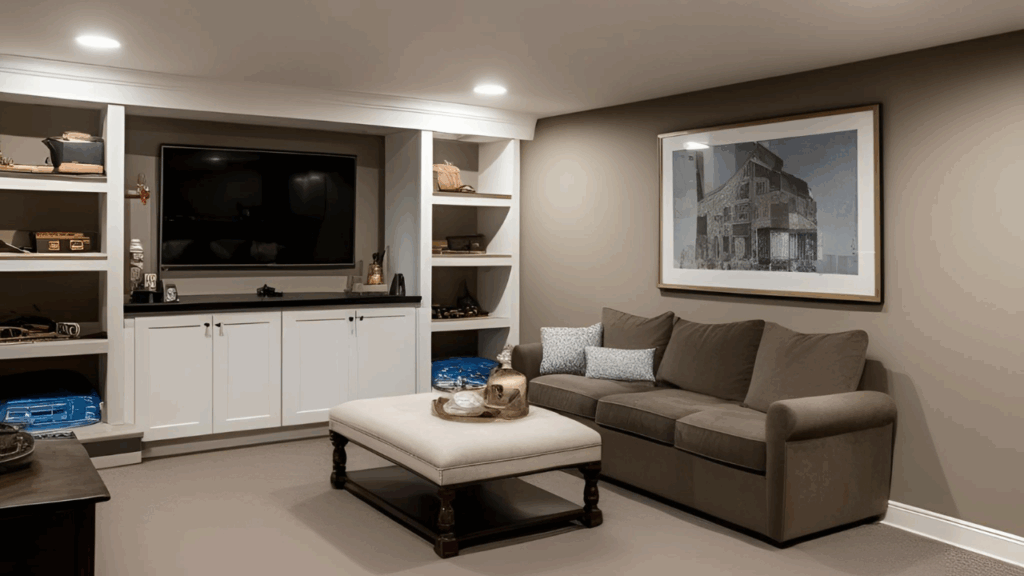
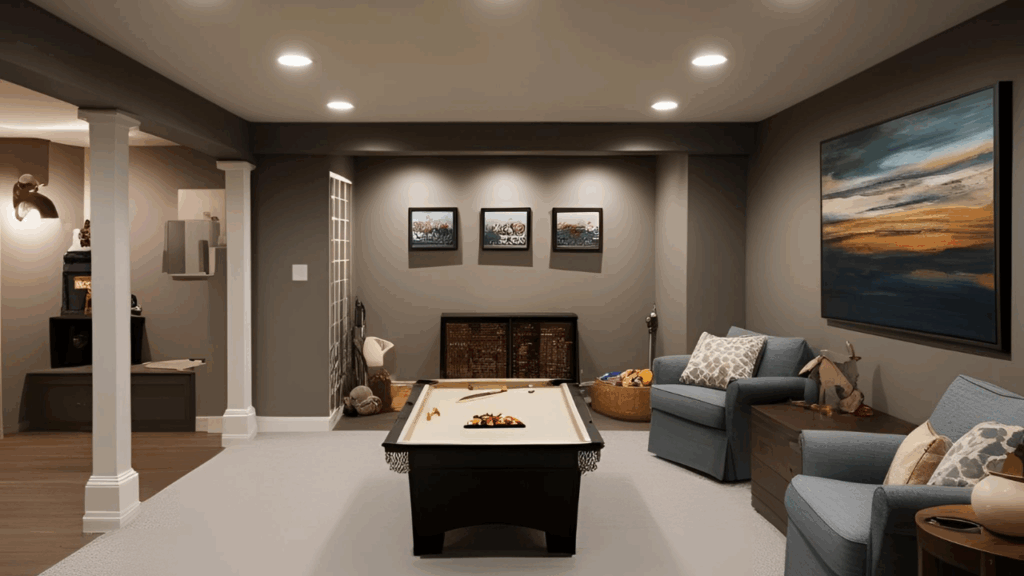
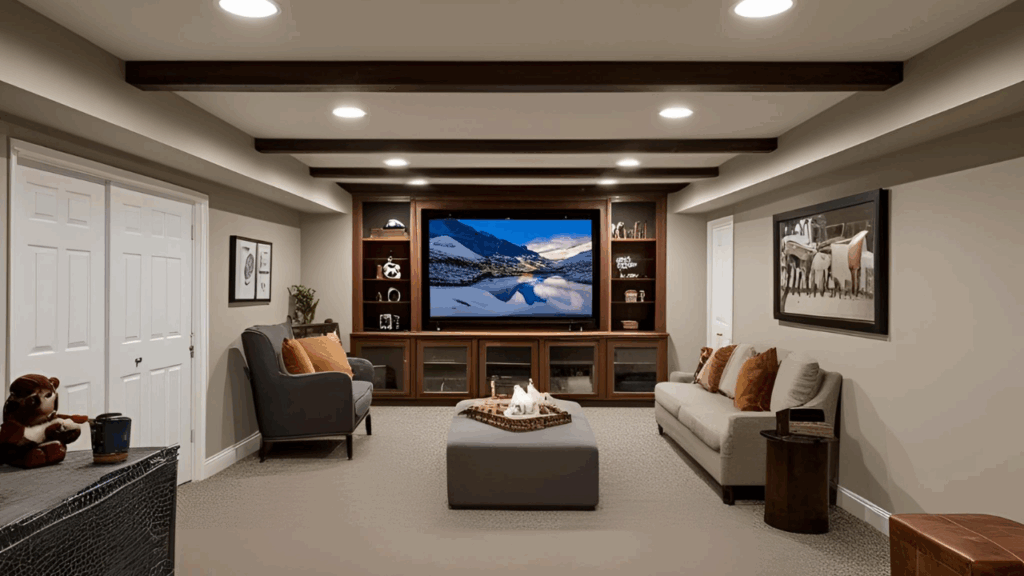
FAQ
What are the primary benefits of a finished basement?
A finished basement adds a lot of usable space. It turns unused areas into useful rooms. You can use it for fun, work, or even rent it out.It also helps with storage and makes your home more energy-efficient.
How does a basement remodel add value to my home?
Remodeling your basement can really boost your home’s value. You can get back about 70% to 75% of what you spend. This is especially true if you add things like extra bathrooms or home offices.
What layout options are available for basement renovations?
You can choose between open layouts for more space or defined areas for privacy. Each has its own benefits. The choice depends on what you want and your home’s style.
How can I create a multi-functional space in my basement?
Use modular furniture and movable walls to make your space flexible. For example, a home office can also be a guest room with a sleeper sofa. This keeps things both useful and cozy.
What should I consider for acoustics and soundproofing in a basement home theater?
For a great sound, use acoustic panels and bass traps. Solid-core doors help too. Good insulation keeps the sound in and makes your movies better.
What seating arrangements are recommended for a basement home theater?
Choose theater recliners, sectionals, or modular seats for the best view. Make sure everyone has a good spot and the space is easy to move around in.
How can I select furniture that works well in my basement family room?
Look for furniture that can handle moisture and is easy to move. Modular sectionals and wall-hugging recliners are good choices. Arrange them to make the room feel welcoming.
What lighting options can brighten up a basement?
Use different types of lighting to make your basement bright and useful. Recessed lights, wall sconces, and LED lamps work well. They help make the space feel more open and inviting.
What ergonomic furniture should I consider for a basement home office?
Get desks and chairs that adjust to fit you. Monitor arms help keep your posture right. This makes working in your basement more comfortable and productive.
How can I enhance my basement home office with technology?
Make sure you have fast internet and built-in charging stations. A tidy workspace is important. Also, think about advanced heating and cooling to keep you and your gear comfortable.
What features enhance the comfort of a basement guest suite?
Focus on good bedding, enough storage, and nice extras like a private bathroom. Soundproofing and adjustable temperature controls make your guest room welcoming.
How can I organize a basement play area for kids?
Use smart storage like toy bins and hidden spots. Make it safe and fun, with lots of room for play. This helps keep things tidy and encourages creativity.
What are some ideal themes for a children’s basement play area?
Themes like underwater worlds, space, and woodland are popular. Add interactive elements and decor that’s right for their age. This creates a space that sparks their imagination.
How should I design a wine cellar or bar in my basement?
Think about the layout and key features like counter depth and appliance space. Good ventilation and moisture control are crucial for keeping your wine and drinks in top shape.
What are some best practices for wine storage in a basement?
Keep the temperature and humidity steady, away from light, and avoid vibrations. Use climate control or insulation to create the perfect wine storage area.
What should I consider when creating a home gym in my basement?
Choose versatile equipment that fits your fitness goals. Plan the layout to make the most of the space. Don’t forget to think about ventilation to control moisture.
How can I create an inspiring atmosphere in my basement gym?
Use mirrors to make the space feel bigger. Pick energizing colors and add technology to help your workouts. Motivational art and adjustable lighting can also boost your gym experience.
What considerations should be made for an efficient basement laundry room?
Arrange appliances to make doing laundry easy. Add utility sinks and ensure good plumbing and ventilation. Look for space-saving solutions like stacked units to keep things organized.
How can I organize my basement laundry room effectively?
Use cabinets made for laundry, vertical storage, and areas for sorting and folding. This keeps your laundry space tidy and functional, solving common problems.
What should I look for when hiring a contractor for a basement remodel?
Check if they have experience with basement projects, especially with moisture. Talk about timelines, communication, and budget to ensure a smooth renovation.
How can I budget effectively for my basement renovation?
Know the cost ranges for different finishes and consider what affects prices. Prioritize based on your budget. Planning for surprises and weighing costs against value helps manage your budget.

